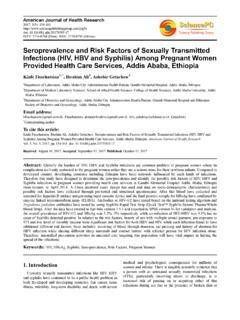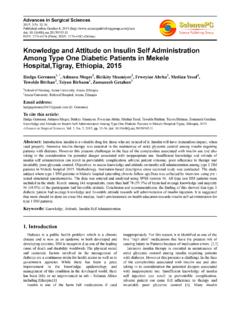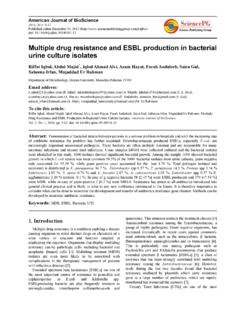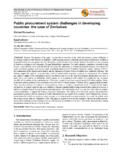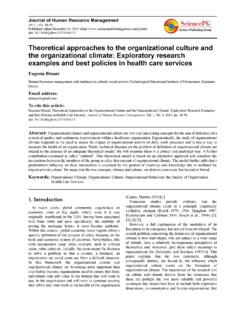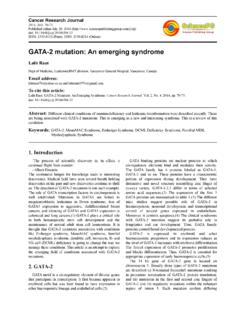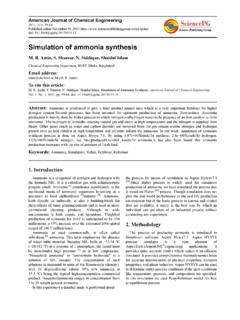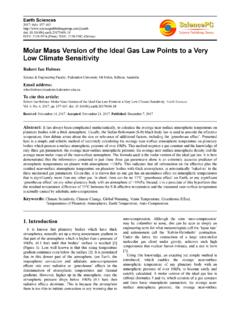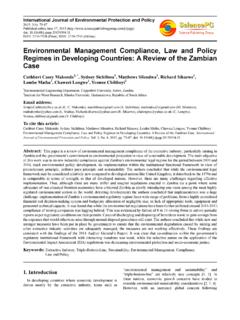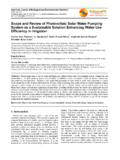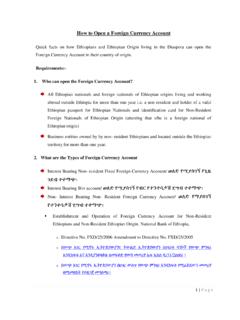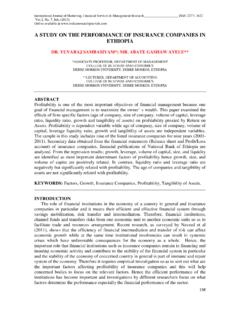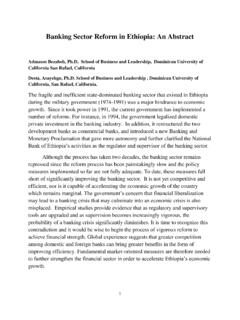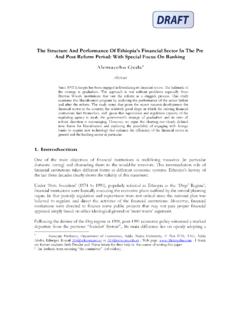Transcription of Assessment of Banking Performance Using Capital …
1 Economics 2015; 4(6): 106-111 Published online October 31, 2015 ( ) doi: ISSN: 2376-659X (Print); ISSN: 2376-6603 (Online) Assessment of Banking Performance Using Capital Adequacy in ethiopia Dakito Alemu1, 2 1 Department of Commerce and Management Studies, College of Arts and Commerce Andhra University, Andhra, India 2 Department of Accounting and Finance, School of Commerce, Addis Ababa University, Addis Ababa, ethiopia Email address: To cite this article: Dakito Alemu. Assessment of Banking Performance Using Capital Adequacy in ethiopia . Economics. Vol. 4, No. 6, 2015, pp. 106-111. doi: Abstract: The data used in this study were collected from financial reports of eight sample banks and national bank of ethiopia (NBE) for the period of 2000-2013.
2 The objectives of the study were to evaluate the financial Performance of Banking sector in the ethiopia and also to see the relation between Capital adequacy and bank s Performance . In order to address these, both descriptive and econometric analyses were employed so as to assess the financial Performance of the sector and the relationship between Capital adequacy and bank Performance . The descriptive analyses were made Using CAMEL approach and central tendency measures. The descriptive data analysis shows that, as compared to other banks NIB s overall Performance was addition to the descriptive data analysis, the study also employed regression model, GLS, which is used to see whether Capital adequacy which is measured by the amount of shareholders fund affect the bank Performance which is measured by Return on asset (ROA).
3 The finding shows that, shareholders fund is the main factor that determines the Performance of Banking industry hence, the null hypothesis is rejected. Therefore, there exists positive relationship between Capital adequacy and bank Performance at 5% significant level, which is in line with theory. Keywords: CAMEL, CAR, LA, GLS, ROA 1. Introduction The growth and stability of the financial condition of a country depend on the soundness of its Banking sector. The firmness of the Banking system is an important concern for regulatory authorities, bank customer and stockholders. To prevent the financial crisis, the Banking activity is heavily regulated all over the world.
4 This involves controlling of bank risk-taking and ensuring compliance with set prudential regulation set by the central bank such as liquidity requirements, Capital adequacy rules, and risk management tools. Financial institutions intermediate between the savers of funds and users of funds. It is hoped that the changes now occurring will enable financial institutions to serve their customers better, strengthen the institutions by broadening and diversifying their operations and promote competition among intermediaries. The history of formal financial system in ethiopia is attached to the establishment of bank of Abyssinia just a century back.
5 bank of Abyssinia was established as the first bank in 1905 based on the agreement signed between the Ethiopian government and the national bank of Egypt, which was owned by the British. Its Capital was 1 million shillings. According to the agreement, the bank was allowed to engage in commercial Banking (selling share, accepting deposit and effecting payments in checks) and to issue currency notes. The agreement prevented the establishment of any other bank in ethiopia , thus giving monopoly right to the bank of Abyssinia. Today there are opportunities to invest in financial institutions with policies encouraging private investors to invest in the Banking , microfinance and insurance companies.
6 Although the history of private commercial banks in the country is very short, the banks have managed to contribute their part in provision of Banking services and sharing the monopolies enjoyed formerly by the state owned Commercial bank of ethiopia . Currently, the number of private commercial banks in ethiopia reached nineteen includes Awash International bank , which is the first private commercial bank . Banks are the most leveraged industry of any economy, so stability and soundness is an important parameter in the Banking system. The main goal of banks in today s financial condition is to maintain stability and make sure that they are 107 Dakito Alemu: Assessment of Banking Performance Using Capital Adequacy in ethiopia resistant to outer shocks while at the same time being sensible and sound from inside.
7 Hence, it is significant to calculate soundness across top banks in the country, spot the weaker sections of this sector, formulate appropriate policies and strategies to raise these sections and finally create an environment that leads this Banking industry to converge in soundness and produce a consistently stable structure. There has been a lot of research literature highlighting these aspects and, to a great extent, showing different associations between these key macroeconomic and financial variables. This paper analyzed the various aspects of Performance and soundness of the Banking Industry in the country Using both CAMEL approach, and econometric analysis.
8 In order to identify the major factors that affects banks Performance as identified by Basel Capital Accord, the study used econometric analysis of the Secondary Data collected from various authentic sources for a period of 14 years, from 2000 to 2013, and provides a simplistic approach to decision makers and shareholders in the judgment of the soundness and stability of banks for long periods. Objectives of the Study The overall objective of the study is to evaluate the financial Performance of commercial banks and assess the relationship between Capital adequacy and Performance . Specific Objectives To examine the financial position of Banking sector in the country To explore the management efficiency of the industry To analyze the asset utilization capacity of Banking sector Te determine the earning capacity of banks in the country To examine the relationship between Capital adequacy and bank Performance .
9 2. Literature Review The financial system especially the Banking sector is highly concentrated. Concentration in the market is a barrier for the presence of a well-built competition and the prevalence of excessive unutilized financial potential in the form of excess reserves and liquidity impedes efficiency of banks. The market structure for commercial banks in the economy is found highly concentrated especially in total assets and deposits towards public banks, especially in total assets and deposits towards public bank , especially the Commercial bank of ethiopia . Size of banks measured by total assets and branch network and age are found negatively related with efficiency while Capital is found to be positively affecting efficiency of banks.
10 The traditional method of approaching the efficiency measurement issue of financial firms, such as banks is the financial ratio analysis. A Performance measure is the specific quantitative representation of a capacity, process, or outcome deemed relevant to the Assessment of Performance . Now days, the most commonly used approach of evaluating the overall Performance of financial institutions as shown/proven in different literatures is CAMEL rating system. Hence, the researcher tried to assess the financial Performance of financial institutions, particularly the Banking sector, Using the both descriptive (CAMEL) and inferential statistics.
